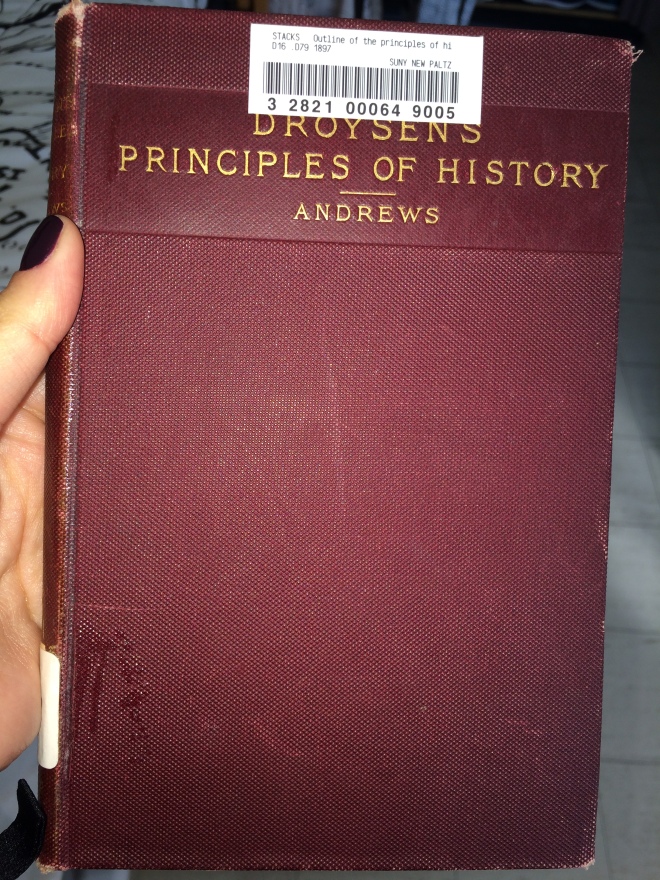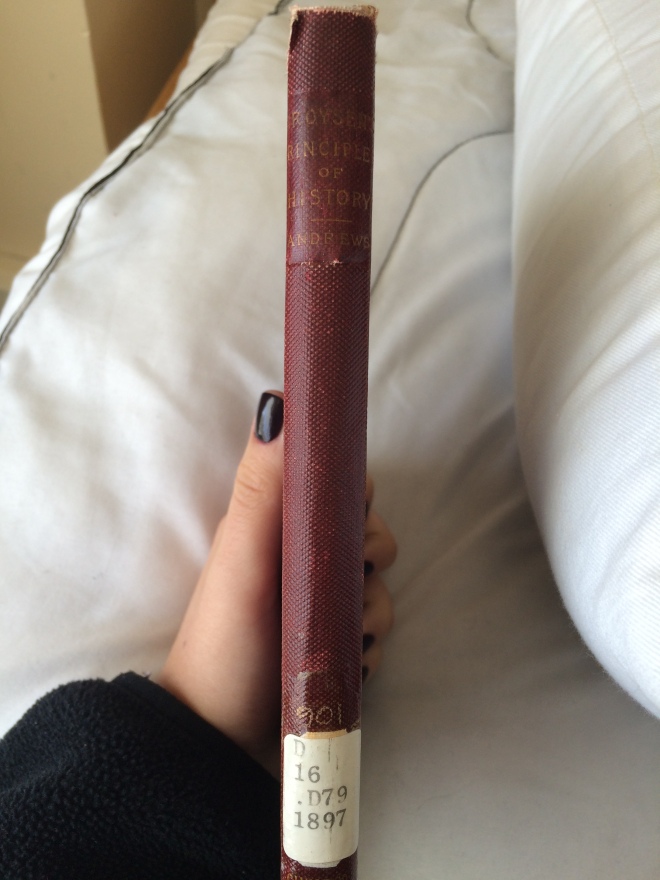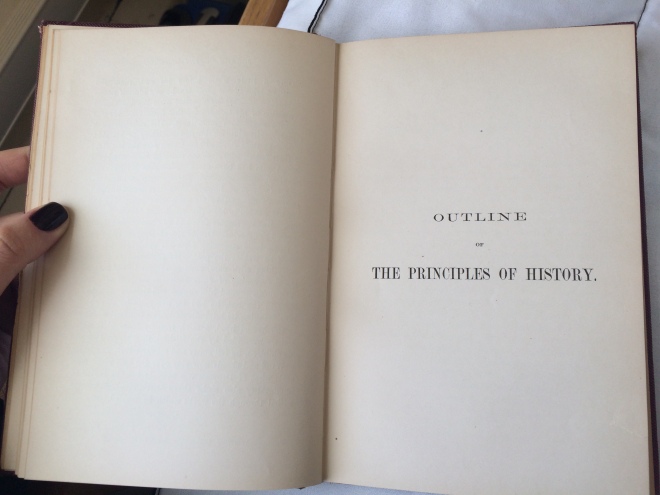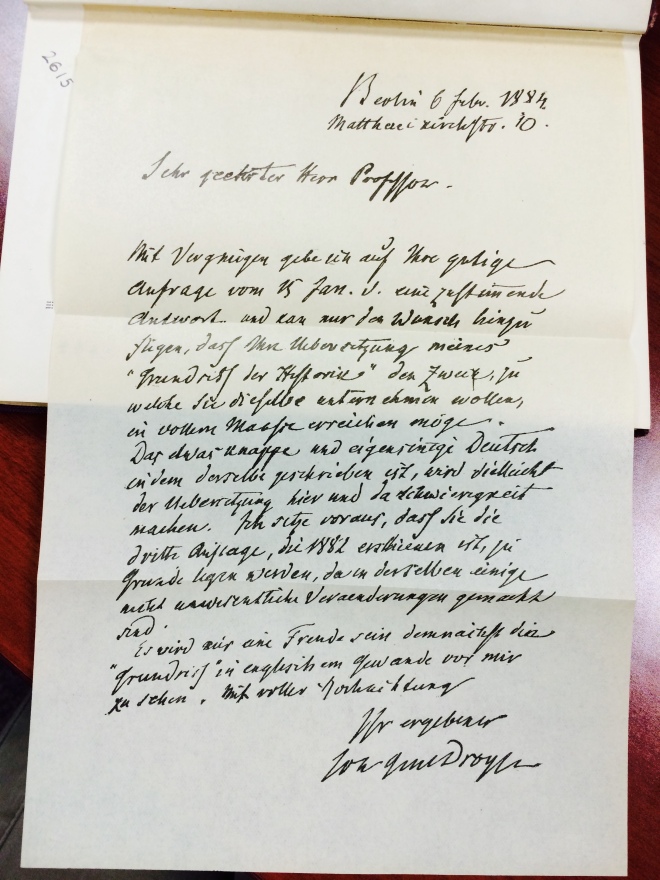When I was looking through the stacks upon stacks of novels, from all different centuries, I found it difficult to find a novel that had the guidelines needed for Book Traces. That was until I discovered a red novel, only a little bit bigger than a diary, and pulled it off the shelf. With only nine minutes left of class, I was worried I would not find anything; but after opening the novel and seeing it was published in 1897, I knew I was on the right track of finding the book I needed. I proceeded to search further into the novel, and right before the contents page I noticed an insert. I opened the insert, and sure enough, it was a handwritten letter written in German! Although it was not the typical marginalia (as in hand written notes or underlining’s), it was still such an interesting find!
My nineteenth century novel is titled Droysen’s Principles of History, and is originally written by Johann Gustav Droysen but translated by E. Benjamin Andrews. Published in 1897 by Ginn and Company, in Boston, this novel is the “Outline of the Principles of History…with a biographical sketch of the author” (as stated on the cover page). Although I cannot translate this letter, due to the scripted handwriting and being written in German, I read the Translator Preface as a reference, and sure enough it became very clear to me why there was an inserted letter in this book. I learned that this letter in fact has nothing to do with the content of the novel, but it rather gives Andrews (the translator) permission to publish Droysen’s Historik in English. Since Andrews did not want to take away the fact that Droysen originally wrote the content, he wanted to ask his permission to see if he would be able to translate the content and publish it. When permission was granted in 1884, Andrews had planned on publishing the novel right away, but with a lot of translating to be done, he found it more suitable to publish the translation years later.
Andrews inserted the letter right before the contents page so that readers would recognize Droysen’s interaction with him, and how Droysen, himself, contributed to making this publication a reality. In respect for Droysen, Andrew wrote a biographical sketch about him and added it to the novel right before the “Outline of the Principles of History” starts. This gives readers taste of the kind of writer Droysen was and the kind of life he lived. Also unique to the translation is the way Andrews took some of Droysen’s complex ideas and broke them down in a way that readers would understand and respond to.
When I decided to Google Droysen, I learned that he was a German historian and often wrote about the “great men” of his era. Ironically enough, Droysen passed away in 1884, the same year he granted permission to Andrews for publication. At the end of this project not only did I learn about Droysen and Andrews, but as well as the physical attributes of a nineteenth century book and what to expect when finding one. Although I could not translate the letter, I still find it remarkable that I found an insert-something I didn’t even know could be!





Dear Annie,
I just found your blog post by chance and being German, I could not resist to try and translate that letter. I tried to keep close to the original instead of writing “nice” English. Here is what I got from it:
Dear Mr. Professor,
with pleasure I give a positive answer to your ?
enquiry from Jan. 15th and would only like to add the wish,
that your translation of my
“Grundriss der Historie” ?
?
will achieve to the full extent.
The quite narrow and obstinate German,
in which it is written, will perhaps
make difficulties to the translation now and then.
I foresee, that you will take as
a basis the third edition, which was published in 1882,
as there are some substantial changes in it.
It will be my pleasure to soon see the
“Grundriß” in english before my eyes.
With high regard
yours
Johann Gustav Droysen
I think that the first ? is “gütige” = kind [to your kind inquiry]
The second and third are: “den Zweck, zu welche[m] sie dieselbe unternehmen wollen” = “will achieve the purpose, you are undertaking this endeavor for”
[that your translation of my “Grundriss der Historie” will achieve the purpose, you are undertaking this endeavor for, to the full extent.]